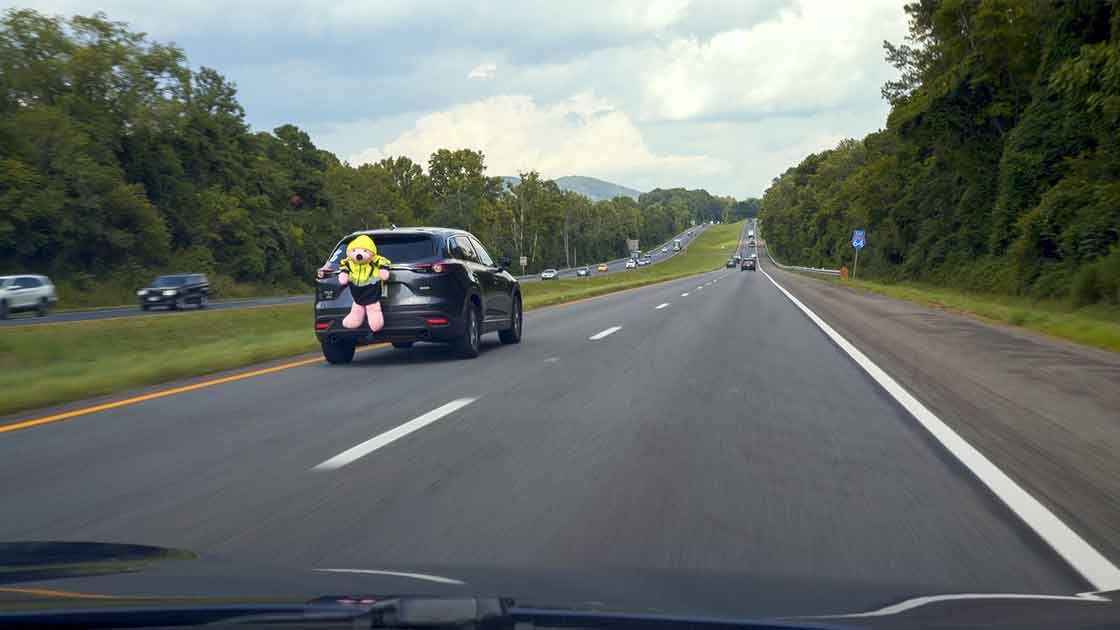IIHS pioneers new method for testing driver attention
March 2, 2021

The latest innovation from the Insurance Institute of Highway Safety isn’t a new crash test or safety award. It’s a giant pink teddy bear.
Looking for a way to measure how aware drivers are of what’s happening on the road around them when they’re using partial automation, IIHS researchers dressed an enormous stuffed bear in a high-visibility jacket and strapped it to the back of a car. They then compared whether three different groups of drivers noticed the bizarre tailpiece when the vehicle overtook them as they motored down an interstate in Maryland.
It’s not as strange as it sounds, says IIHS Research Scientist Alexandra Mueller, who developed the concept. Or, rather, it’s the weirdness that makes it work.
“There are a number of laboratory methods for measuring situational awareness, but they don’t work so well on the road,” Mueller says. “The giant teddy bear on the back of the vehicle helps give us an objective measure of the driver’s focus that’s relevant to driving and doesn’t interfere with how that person normally drives.”
That measure is useful because today’s partial automation systems still aren’t fully autonomous.
Under the classification system developed by SAE International, automation is classified from 0 (no automation) to 5 (fully self-driving). The highest level available in production vehicles today is Level 2. These systems continuously control acceleration, braking and steering to keep the vehicle traveling at a set speed in the center of its lane while maintaining a selected following distance from the vehicle ahead.
As a number of highly publicized crashes have demonstrated, however, Level 2 systems sometimes struggle to handle common road features and driving scenarios, so they require constant supervision by the driver. Research has also shown that it’s harder for drivers to remain focused on the road when they no longer have to make the constant steering and speed adjustments they’re accustomed to making when driving manually. Scientists need a robust way to study this problem in real-world driving conditions in order to understand whether the technology affects all drivers the same way.
To test the teddy bear concept, IIHS observed 31 drivers as they drove a 2019 Mercedes-Benz C300 for about an hour on a Maryland stretch of I-70. One set of drivers who regularly used similar Level 2 systems in their own vehicles drove with the Mercedes-Benz’s partially automated feature switched on, as did another group of drivers who had little or no experience with these types of systems. A third group that was also unfamiliar with Level 2 automation completed the trip in the same vehicle but left the automation switched off.
During the trip, the vehicle with the pink teddy bear overtook each driver three times and remained in view in front for approximately 30 seconds. Cameras inside the test vehicle recorded where the driver was looking as well as the view of the road through the windshield. After the trip, the drivers were asked whether they had seen anything odd about any vehicles they had encountered and, if they had, how many times they had seen it.
The researchers observed clear differences in how successfully the three groups of drivers took note of the hard-to-miss bear, suggesting that the method effectively provided an objective measure of situational awareness.
More than twice as many inexperienced Level 2 automation users driving with the system turned on failed to recall the bear at all compared with the other groups. Almost all of the frequent Level 2 automation users who had the vehicle’s system switched on noticed the bear. They were also more likely than the other groups to correctly recall the number of times it had appeared during the drive.
The researchers also analyzed the video data and found that drivers who better recalled the bear also tended to spend more time scanning the forward roadway as well as looking out of the driver and front passenger windows, where the bear emerged into view as the vehicle carrying it passed them. In contrast, drivers who missed the bear tended to spend more time looking straight ahead.
Though the sample was small, these results suggest that partially automated driving systems have the potential to improve drivers’ situational awareness after they have gained experience using the technology. Inexperienced drivers may have more difficulty keeping track of what’s going on around them when using the unfamiliar technology than when driving without it.
On the other hand, previous studies have shown that familiarity with automation can also have drawbacks. Users can become complacent as their trust in the technology grows. That makes them more likely to check their phones or fiddle with the navigation or audio system than they would do while driving manually — a problem that has already been implicated in several serious crashes.
“Using a stuffed animal as a research tool may sound a little funny, but the method works,” Mueller says. “That big pink teddy bear could lead to a better understanding of attention issues that are critical for safety."